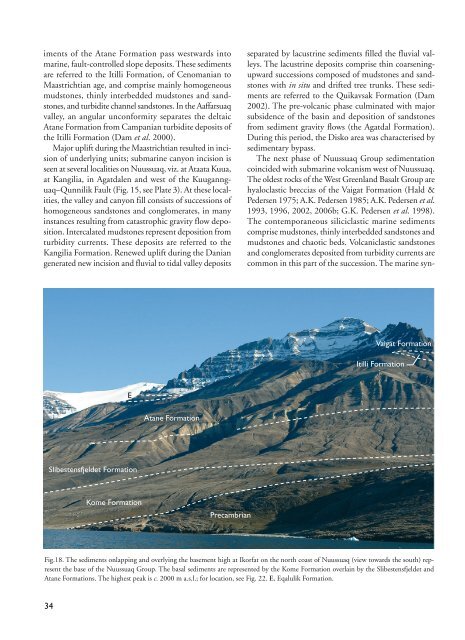Geological Survey of Denmark and Greenland Bulletin 19 ... - Geus
Geological Survey of Denmark and Greenland Bulletin 19 ... - Geus
Geological Survey of Denmark and Greenland Bulletin 19 ... - Geus
You also want an ePaper? Increase the reach of your titles
YUMPU automatically turns print PDFs into web optimized ePapers that Google loves.
iments <strong>of</strong> the Atane Formation pass westwards into<br />
marine, fault-controlled slope deposits. These sediments<br />
are referred to the Itilli Formation, <strong>of</strong> Cenomanian to<br />
Maastrichtian age, <strong>and</strong> comprise mainly homogeneous<br />
mudstones, thinly interbedded mudstones <strong>and</strong> s<strong>and</strong>stones,<br />
<strong>and</strong> turbidite channel s<strong>and</strong>stones. In the Aaffarsuaq<br />
valley, an angular unconformity separates the deltaic<br />
Atane Formation from Campanian turbidite deposits <strong>of</strong><br />
the Itilli Formation (Dam et al. 2000).<br />
Major uplift during the Maastrichtian resulted in incision<br />
<strong>of</strong> underlying units; submarine canyon incision is<br />
seen at several localities on Nuussuaq, viz. at Ataata Kuua,<br />
at Kangilia, in Agatdalen <strong>and</strong> west <strong>of</strong> the Kuuganng -<br />
uaq–Qunnilik Fault (Fig. 15, see Plate 3). At these localities,<br />
the valley <strong>and</strong> canyon fill consists <strong>of</strong> successions <strong>of</strong><br />
homogeneous s<strong>and</strong>stones <strong>and</strong> conglomerates, in many<br />
instances resulting from catastrophic gravity flow deposition.<br />
Intercalated mudstones represent deposition from<br />
turbidity currents. These deposits are referred to the<br />
Kangilia Formation. Renewed uplift during the Danian<br />
generated new incision <strong>and</strong> fluvial to tidal valley deposits<br />
separated by lacustrine sediments filled the fluvial valleys.<br />
The lacustrine deposits comprise thin coarseningupward<br />
successions composed <strong>of</strong> mudstones <strong>and</strong> s<strong>and</strong> -<br />
stones with in situ <strong>and</strong> drifted tree trunks. These sed i -<br />
ments are referred to the Quikavsak Formation (Dam<br />
2002). The pre-volcanic phase culminated with major<br />
subsidence <strong>of</strong> the basin <strong>and</strong> deposition <strong>of</strong> s<strong>and</strong>stones<br />
from sediment gravity flows (the Agatdal Formation).<br />
During this period, the Disko area was characterised by<br />
sedimentary bypass.<br />
The next phase <strong>of</strong> Nuussuaq Group sedimentation<br />
coincided with submarine volcanism west <strong>of</strong> Nuussuaq.<br />
The oldest rocks <strong>of</strong> the West Greenl<strong>and</strong> Basalt Group are<br />
hyaloclastic breccias <strong>of</strong> the Vaigat Formation (Hald &<br />
Pedersen <strong>19</strong>75; A.K. Pedersen <strong>19</strong>85; A.K. Pedersen et al.<br />
<strong>19</strong>93, <strong>19</strong>96, 2002, 2006b; G.K. Pedersen et al. <strong>19</strong>98).<br />
The contemporaneous siliciclastic marine sediments<br />
com prise mudstones, thinly interbedded s<strong>and</strong>stones <strong>and</strong><br />
mudstones <strong>and</strong> chaotic beds. Volcaniclastic s<strong>and</strong>stones<br />
<strong>and</strong> conglomerates deposited from turbidity currents are<br />
common in this part <strong>of</strong> the succession. The marine syn-<br />
Vaigat Formation<br />
Itilli Formation<br />
E<br />
Atane Formation<br />
Slibestensfjeldet Formation<br />
Kome Formation<br />
Precambrian<br />
Fig.18. The sediments onlapping <strong>and</strong> overlying the basement high at Ikorfat on the north coast <strong>of</strong> Nuussuaq (view towards the south) represent<br />
the base <strong>of</strong> the Nuussuaq Group. The basal sediments are represented by the Kome Formation overlain by the Slibestensfjeldet <strong>and</strong><br />
Atane Formations. The highest peak is c. 2000 m a.s.l.; for location, see Fig. 22. E, Eqalulik Formation.<br />
34
















